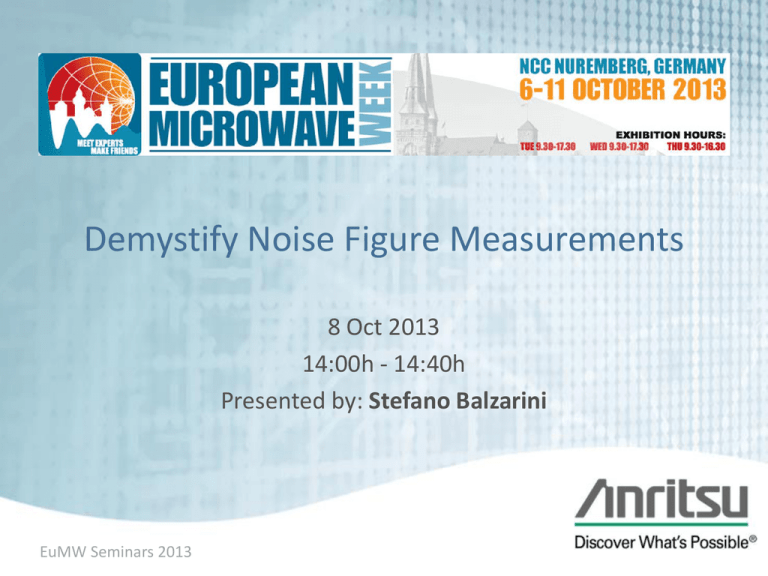Implementations: Composite Receiver
advertisement

Demystify Noise Figure Measurements 8 Oct 2013 14:00h - 14:40h Presented by: Stefano Balzarini EuMW Seminars 2013 Agenda • Background • Definition and Importance • Methods • Y-factor (or hot/cold) • Cold source • Implementations • Composite receiver • Importance of linearity and gain adequacy • Measurement steps • Uncertainties • The basic model, terms of interest • What really matters? • The Uncertainty Calculator • Summary EuMW Seminars 2013 2 Definition F = Noise Factor Si = Input signal power Ni = Input noise power So = Output signal power No = Output noise power F GDUT = Gain of amplifier Nadded = Noise added by amplifier S N S N input 1 GDUT N input GDUT N added N input output Noise figure (NF) is: NF (dB) = 10 * log (F) Easy enough…a quasi-normalized measure of noise power added by the DUT. However, many there are assumptions made about the impedance environment, the type of signals in the measurement, temperatures, etc. EuMW Seminars 2013 3 Noise Parameters What are noise parameters? A measured NF value is only valid for a source impedance of 50 ohms (usually). At other impedances, the practical noise figure varies and is DUT dependent (usually). Source reflection coefficient for minimum NF Equivalent noise resistance F Fmin 4 R n Γ S Γ opt 2 2 Z 0 1 Γ S 1 Γ opt 2 +j1.0 +j0.5 +j2.0 5.0 2.0 1.0 0.5 0.0 +j5.0 0.2 +j0.2 -j0.2 -j5.0 -j0.5 Concept: present different source reflection coefficients (with tuner) and measure NF; solve for the unknowns -j2.0 -j1.0 EuMW Seminars 2013 4 Importance Why is NF important? - Cellular systems voice quality - Digital communications bit-error rate - Radar range Relative cost for amplifiers within one 3350 GHz family 3 Normalized price Because of this importance, - NF is still a critical customer-vendor specification - It sometimes has a steep cost-function (especially for ultra-low-noise cases and at mm-wave frequencies) 2 1 0 2 EuMW Seminars 2013 5 3 4 Specified noise figure (dB) 5 NF Methods: Y-factor (hot-cold) What is it? Historic method that is based on a ratio of noise powers (avoids absolute power cal). Noise source Noise receiver + preamps… DUT Composite Receiver @ TC and TH Noise power is measured when driven with a source in a cold state (near room temp) and a hot state (often with 10-20 dB more noise power). Y Y-Factor output Excess Noise Ratio = [(TH - TC) / T0] ENRdB = 10 log10 [(TH - TC) / T0] To = 290o Kelvin input Noise power Cold state Hot state F Time EuMW Seminars 2013 Noutput _ hot Noutput _ cold 6 ENR 1 Y 1 NF Methods: Y-factor Noise Source Issues: • Difficult to calibrate • Significant uncertainty-adder (often > 0.15 dB) • Fragile (will go way out-of-cal if dropped) • Impedances in hot and cold states are not equal (problems both from power delivery and from noise parameters) High gain broadband amps can actually be damaged by the hot state. |Gs| for hot and cold states EuMW Seminars 2013 7 Methods: Cold Source What is it? An absolute noise power difference (not a relative one like before) Implication: Need an accurate receiver cal/power cal The only input to the DUT is the noise power (kT0B) from a termination at T0, nominally a load From the S/N definition: F Result for cascaded system: EuMW Seminars 2013 S N S N Composite receiver input 1 kT0B Nadded Bandwidth (B) is set by the IF system; can be known a priori G kT0B output FDUT 1 GDUT 8 NDUT rcvr Nrcvr GDUTkT0B Methods: Cold Source Cold source is the generally accepted methodology used by VNA and applied up to ~70 GHz until the recent announcement from Anritsu … Industry-first! 70 kHz to 125 GHz VNA Noise figure measurement capability Industry-first! Optimized noise receiver for measurements from 30 GHz to 125 GHz EuMW Seminars 2013 9 Measuring Noise Power Noise power can be measured statistically A deterministic background signal IF time By acquiring many samples and performing an RMS-like calculation, slowly-varying or constant interferers are removed. N Noise_powe r EuMW Seminars 2013 k 1 10 b 2,k N 2 N b k 1 2,k N 2 Noise Power Measurement Trade-offs Selection of acquisition parameters (IFBW) and # of RMS points: - Trade-off between data jitter and sweep time - 100 kHz/3000 is default - 10 kHz/6000 for ~0.1 dB jitter at reasonable gains NF (dB) Data jitter vs. acqusition settings 6 10kHz/6000 5 10kHz/2000 100kHz/6000 The dependence is stronger at parameter extremes and in lownet-gain situations. 4 3 6 EuMW Seminars 2013 7 Frequency (GHz) 8 11 Methods: Cold Source (cont.) Considerations with the cold source method: Accuracy of the power/receiver calibration: The power calibration can be affected by mismatch, sensor linearity, harmonic contributions,… Tighter linearity constraints: Since it is more of an absolute noise power measurement, receiver linearity problems map directly to NF uncertainty (including linearity between receiver cal level and measurement level). EuMW Seminars 2013 12 Implementations: Composite Receiver Accurate noise figure measurements require high composite receiver gain and appropriate filtering. External Component Benefits B • • Composite receiver • Greater flexibility in composite receiver design Can optimize for best performance with DUT Easier to service and maintain The difference is whether the components for the composite receiver are inside or outside. If inside, a lot of switching and IF receiver modifications are needed - which can degrade performance of the standard s-parameter measurements. EuMW Seminars 2013 13 Implementation: VS mm-wave A separate receiver module • Based on unique 3743A Freq Ext Mod o 8% the weight and 2% the volume of other solutions • coupling loss deleted, • un-needed multiplier paths removed • receiver input better matched Still need to incorporate into a composite receiver with external components EuMW Seminars 2013 14 Implementations: Composite Receiver Two key components: pre-amplifiers and filter(s): • Select the proper amplification such that the resultant noise power into the VNA receiver is: • • • Not too low. Not too high. For VectorStar™, generally want composite receiver gain + DUT gain between ~40 dB and 70 dB for linearity optimization. • • Using multiple pre-amplifiers is ok. Lower pre-amplifier noise figures are better. But if the DUT gain exceeds ~10 dB, it does not matter much. EuMW Seminars 2013 15 Implementations: Composite Receiver Example: What may cause low end linearity issue? -Discretization floor of flipping a few least significant bits (LSBs) -Integral nonlinearity (INL) of the ADC – sometimes related to charge storage in the sample and hold circuit dBFS output ADC integral nonlinearity effect (14 bit, typical) -40 Rarely plotted this way by ADC manufacturers, but it can be important for noise signals -50 ideal practical -60 -60 EuMW Seminars 2013 -50 dBFS input -40 16 Implementations: Composite Receiver Select the proper filtering to minimize unwanted images: • • • Most VNAs incorporate harmonic downconversion Any downconverter has responses for at least some harmonics of the LO (commonly 3rd, 5th, 7th… for balanced mixers and all harmonics for some structures). Isolate the harmonic of interest • Example: Measuring amplifier NF at 18 GHz 9 18 27 36 EuMW Seminars 2013 – The receiver will be “listening” at sub- and super-multiples of 18 GHz. – If the pre-amps have gain there, use filters. – If the preamps only covered 1-20 GHz, a high pass filter might be adequate. 17 Implementations: Composite Receiver Limited The example below highlights the effects of having a limited noise figure measurement range. Another instrument: Too low pre-amp gain Too low a preamp gain just right (~35 dB) Just right too(~40 much Too much gain dB)gain...(~40 dB) 4 4 3 3 2 -2 NF (dB) NF (dB) NF (dB) 6 2 1 1 30 dB gain preamp 2 20 dB gain preamp -6 0 0 1.5 1.7 1.9 2.1 Frequency (GHz) EuMW Seminars 2013 2.3 2.5 1.5 1.7 18 1.9 2.1 Frequency (GHz) 2.3 2.5 1.5 1.7 1.9 2.1 Frequency (GHz) 2.3 2.5 Implementation: VS- Measurement Process FDUT 1 GDUT NDUT rcvr Nrcvr GDUTkT0B Three main steps: 1. Receiver calibration (may include a power cal) 2. Noise calibration 3. DUT measurement B DUT gain (GDUT) should be measured beforehand. T0 is room temperature, nominally. B is the IF bandwidth of the VNA. Depending on the DUT, 30-50 dB gain EuMW Seminars 2013 19 Need to avoid images Implementation: DUT Gain Measurement A note about the DUT gain measurement … make sure the DUT is nowhere near compression. NF vs. S-parameter compression 7 NF (dB) 6 start 5 .3 dB compressed 4 1 dB compressed 3 5 EuMW Seminars 2013 6 Frequency (GHz) 7 20 Implementation: Receiver calibration • Establish absolute power reference - Power calibrations help accuracy considerably • Must be done at a low level (usually about -50 to -60 dBm) due to the use of the composite receiver B Power cal at this plane over the relevant frequency list EuMW Seminars 2013 21 Implementation: Receiver calibration Comparison between using a noise source or VNA source (with power meter calibration) as the absolute power reference Noise Source VNA Source Re-calibration complexity Stability of source calibration (vibration) More thermal instability Match variance Higher fundamental uncertainty Need +28V switching and timing control with Power Cal Better calibration stability Better fundamental uncertainty Easier handling of different signal levels EuMW Seminars 2013 22 Implementation: Noise calibration Measurement of the noise power of the receiver with input terminated. B EuMW Seminars 2013 23 Implementation: DUT measurement Insert the DUT to make the NF measurement. B NOTE: It is worthwhile to check the absolute power being delivered to the VNA receiver to ensure that the receiver is not being overdriven. EuMW Seminars 2013 24 Implementation: Comparisons ZJL-6G amplifier 5.5 NF (dB) 5 4.5 4 VS -041 8970 upper2 lower2 3.5 0.1 0.6 1.1 Frequency (GHz) Preamp linearity issues EuMW Seminars 2013 25 1.6 Uncertainties NF measurement uncertainty can be affected by many factors: B Residual image responses, discrete leakage and RMS computation scatter DUT S-parameter uncertainty Mismatch Mismatch, composite receiver linearity (net gain), composite receiver NF, receiver cal accuracy 𝐹= 1 𝐺+∆𝐺 + ((𝑁𝐷𝑈𝑇+𝑟𝑐𝑣𝑟 − 𝑁𝑟𝑐𝑣𝑟 )+(∆𝑁𝐷𝑈𝑇+𝑟𝑐𝑣𝑟 − ∆𝑁𝑟𝑐𝑣𝑟 ))(1+∆𝑅) 𝑘𝑇0 𝐵(𝐺+∆𝐺) EuMW Seminars 2013 26 Uncertainties: What matters? • Receiver gain when the DUT gain drops Example amplifier @ 10 GHz Receiver gain (dB) Noise figure (dB) Required receiver gain for 0.3 dB uncertainty on example amplifier Fixed 40 dB rcvr gain 4 3 nominal upper lower 2 0 20 DUT gain (dB) 20 0 10 30 50 Frequency (GHz) 70 40 With fixed composite receiver gain, as DUT gain drops, uncertainty increases EuMW Seminars 2013 40 More composite receiver gain is needed to keep the same uncertainty as the DUT gain drops 27 Uncertainties: What matters? • Match, particularly between DUT and receiver Unc. on example 3 dB NF amp (dB) Uncertainty vs. mismatch EuMW Seminars 2013 1 |S22|=-15 dB |S22|=-6 dB 0.5 0 -30 -25 -20 -15 Receiver match (dB) 28 -10 Uncertainties: What matters? • Power cal/receiver cal accuracy Unc. on example 3 dB NF amp (dB) Uncertainty vs. power accuracy (into rcvr cal) 1 0.5 0 0 0.2 0.4 0.6 Power accuracy (dB) At low power uncertainties, other terms dominate EuMW Seminars 2013 29 0.8 1 Uncertainties: Calculator 3 basic modes of operation: (enter fixed or actual DUT .s2p and NF data as well as various measurement parameters) - Uncertainty vs. frequency - Uncertainty vs. DUT gain (at one frequency) - Required receiver gain (vs. frequency) for a given uncertainty EuMW Seminars 2013 30 Summary • Background • Definition and Importance • Methods • Y-factor (or hot/cold) • Cold source • Implementations MS4640B-041 Noise Figure Measurement • Composite receiver • Importance of linearity and gain adequacy • Measurement steps • Uncertainties • The basic model, terms of interest • What really matters? • The Uncertainty Calculator EuMW Seminars 2013 31







